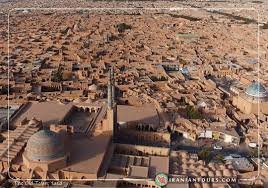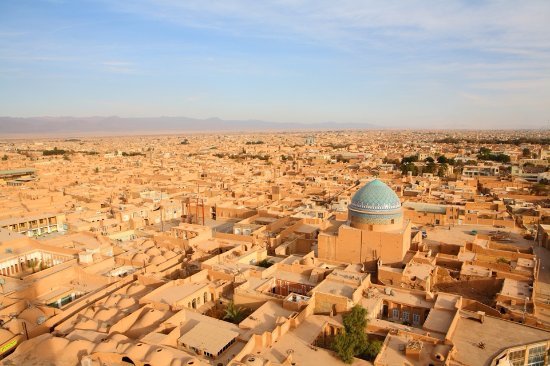In the heart of Iran’s central desert lies Yazd, a city that has perfected the art of underground survival for over 5,000 years. This UNESCO World Heritage site represents one of humanity’s most ingenious adaptations to extreme environments, where an elaborate labyrinth of qanat tunnels brings mountain water to the desert, ancient windcatchers create natural air conditioning, and eerie Towers of Silence stand as monuments to Zoroastrian death rituals. Yazd’s mud-brick skyline, punctuated by ornate badgirs (wind towers) and domed rooftops, conceals a vast subterranean world that sustained life in this inhospitable landscape where summer temperatures reach 50°C (122°F). The city’s unique fusion of Zoroastrian traditions, Islamic architecture, and pre-industrial engineering makes it a living museum of Persian civilization’s resilience, with secrets still being uncovered beneath its winding alleyways.
The Qanat Masters: Engineering Miracles Beneath the Desert
Yazd’s lifeblood flows through its 2,500-mile qanat network – ancient underground aqueducts that tap mountain aquifers using only gravity. These hand-dug tunnels, some dating back 3,000 years, slope precisely 1 meter per kilometer to maintain ideal water flow. The system’s sophistication still astonishes engineers:
- Vertical shafts every 20-50 meters for ventilation and maintenance
- Underground reservoirs (ab anbars) with natural refrigeration
- Sedimentation chambers that self-clean the water
- Qanat-born waterfalls in unexpected desert locations
Master diggers (muqannis) passed their craft secretly for generations, using constellations to align tunnels and listening to ground sounds to detect water. In 2016, archaeologists discovered a massive qanat beneath Yazd’s Jameh Mosque with a hidden chamber containing 10th-century water measurement devices. Today, only about 200 qanats remain active, but their cool, shaded corridors now serve as subterranean tea houses and emergency shelters during dust storms.
Windcatchers: Ancient Persian Air Conditioning
Yazd’s iconic badgirs represent the world’s first climate control system. These towering structures capture high-altitude breezes, funneling them down through buildings and across water surfaces to create evaporative cooling. The most advanced examples demonstrate remarkable sophistication:
- Multi-directional windcatchers that rotate to track wind changes
- Internal dampers to regulate airflow like modern HVAC
- Underground ice chambers cooled by winter winds
- Some capable of lowering temperatures by 15°C (27°F)
The Dowlat Abad Garden boasts a 33-meter badgir – the tallest extant example – whose design creates constant airflow even during still summer nights. Recent studies show these structures inspired modern wind tower designs in Masdar City and other eco-friendly projects. At night, the windcatchers’ openings glow with reflected lantern light, creating the illusion of stars captured within the towers.
Towers of Silence: Zoroastrian Sky Burials
On barren hills surrounding Yazd stand circular, walled structures called dakhmas – the last active Towers of Silence where Zoroastrians traditionally exposed their dead to scavenging birds. This practice, abandoned in the 1960s but maintained ceremonially, reflects the belief that earth burial pollutes the sacred elements. The towers’ chilling features include:
- Three concentric circles (men, women, children) for corpse placement
- Central ossuary pits where bones were collected after decomposition
- Precise alignment with solstice sun positions
- Special “mourner’s path” preventing contamination of the living
Modern visitors describe an eerie stillness at these sites, where the absence of insects and wildlife remains unexplained. At sunset, the towers cast elongated shadows that some claim reveal hidden Zoroastrian symbols in their patterns. The nearby “Zoroastrian Eternal Flame” has reportedly burned continuously since 470 AD, tended by the same priestly family for 32 generations.
The Underground City of Narej Fortress
Beneath Yazd’s northern districts lies a little-known subterranean complex called Narej Fortress – a 3-level emergency refuge capable of sheltering 5,000 people. Rediscovered in 2014, this maze-like structure includes:
- 18 interconnected chambers with 9-meter ceilings
- Hidden wells tapping the qanat system
- Ventilation shafts disguised as natural rock formations
- Escape tunnels stretching 4km to the mountains
Archaeologists believe it served as both a wartime shelter and hot-season residence, with wall carvings suggesting some areas were used for Zoroastrian rituals. The most puzzling discovery was a chamber containing hundreds of identical ceramic spheres – possibly ancient food preservation devices or ritual objects.

Yazd’s Fire Temple and the Sacred Flame
Atash Behram, Yazd’s Zoroastrian fire temple, houses a flame said to have burned since 470 AD, fed by sandalwood and tended by hereditary priests. The temple’s secrets include:
- A silver-faced altar reflecting the fire’s purity
- Underground chambers where 16 different fire types were ritually purified
- A hidden library of Avestan manuscripts
- An acoustic system amplifying prayers while dampening outside noise
The fire’s continuity is maintained through a complex ceremony where new flames are kindled from 1,016 separate fires, including lightning strikes and furnace sparks. During Nowruz (Persian New Year), the flame turns an unusual blue color – a phenomenon scientists attribute to copper salts in the sandalwood.
The Labyrinthine Old Quarter
Yazd’s medieval Fahadan district is a deliberate maze designed to confuse invaders and maximize shade. Its features demonstrate brilliant urban planning:
- Alleyways narrowing to 40cm to block sunlight
- Rooftop pathways connecting homes for women’s private movement
- Hidden courtyards with central pools for microclimate cooling
- “Whispering walls” that carry sounds across blocks
Getting lost here is inevitable – even Google Maps fails in the twisting passages where some dead-ends suddenly open into vibrant pomegranate gardens. The quarter’s most famous residence is the 18th-century Khan-e Lari house, whose stained-glass windows project rainbow patterns that track seasonal changes like a giant sundial.
Yazd’s Living Handicraft Traditions
The city maintains artisanal crafts unchanged for millennia:
- Silk weaving on 500-year-old looms producing patterns with 1,200 threads/inch
- Qanat-based water mills still grinding wheat as in Sassanian times
- Underground pottery workshops where desert minerals create unique turquoise glazes
- Confectioners making baklava with qanat-cooled rosewater
Most extraordinary are the “earth architects” who repair ancient buildings using a 3,000-year-old mud-brick recipe incorporating egg whites, camel milk, and a secret desert plant extract that repels insects. Their restoration of the 14th-century Amir Chakhmaq Complex revealed hidden chambers containing Timurid-era astronomical instruments.
Modern Yazd: Preserving the Past
Today, Yazd faces the challenge of maintaining its heritage while modernizing. Innovative solutions include:
- Solar panel installations designed like traditional badgirs
- Qanat water being used for geothermal cooling in new buildings
- The world’s first “Underground Hotel” built in abandoned qanat tunnels
- University programs training new muqannis in ancient qanat-digging techniques
Nighttime walking tours reveal the city’s magical transformation as thousands of badgirs glow against the desert sky, while below ground, the qanat waters still whisper secrets of Persia’s ingenious ancestors. Yazd stands not as a relic, but as a living testament to human ingenuity – proving that even in the harshest environments, civilization can not only survive, but flourish with breathtaking creativity.
Wandering Yazd’s shadowy lanes, where the scent of rosewater mixes with desert winds and the sound of qanat waters murmurs beneath your feet, you experience a city that has truly mastered the art of living with – rather than against – its extreme environment. From the soaring windcatchers to the depths of its ancient water tunnels, Yazd offers an unforgettable journey through layers of history, technology, and spirituality that continue to shape sustainable design worldwide. This desert jewel reminds us that the past holds powerful solutions for our future.
Go to main page


